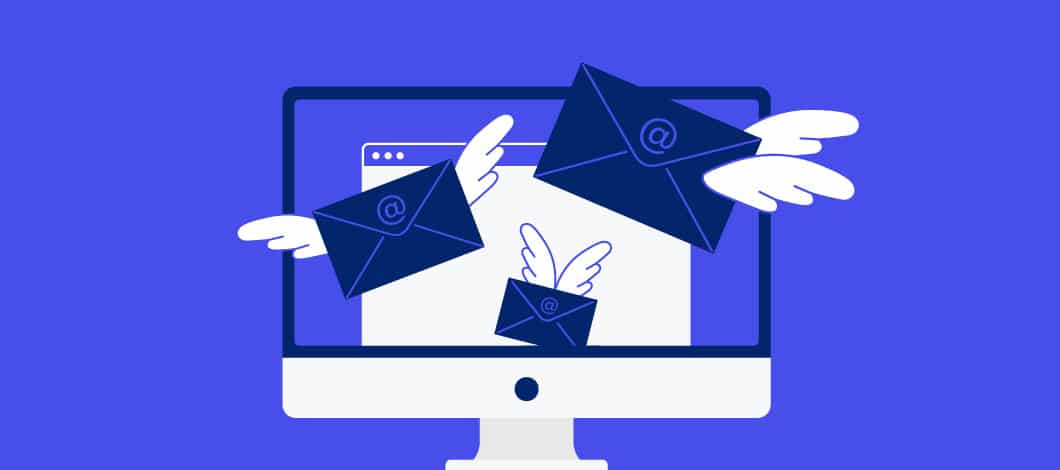Email marketing is the simple act of communicating brand information, content and deals with your customers and prospects via email.
Despite the popularity of social media, 60% of consumers still prefer to receive promotions in their email inboxes, according to software company Optinmonster. That makes email marketing an essential piece of your digital marketing playbook.
Although it’s a simple act of communication at its core, email marketing takes a lot of work and creativity. And if you haven’t invested enough into this key marketing strategy, you aren’t alone. About 13% of marketing dollars were spent in email marketing in 2019 despite its impact on 19% of sales, according to Econsultancy.
If you aren’t doing it, it’s time to start. Our beginner’s guide will help you learn how to do email marketing right.
What Is Email Marketing?
In basic email marketing, you send emails to customers on a regular schedule to highlight promotions, share stories, provide helpful information or spread company news. This can be done manually but is usually better accomplished with an email campaign generator such as Mailchimp, Klaviyo or Constant Contact. Services such as these allow you to automate additional email marketing strategies such as newsletter welcome messages or abandoned cart emails.
In the digital age, there are countless ways to communicate with your audience — from each social media channel to your website to your app — and each has value. None of them allows you to cover as much ground and convey as many types of information quite as easily as email, though.
In a certain sense, “email marketing” is a misnomer that distills this important act down to only an act of promotion. But it’s so much more than that.
The Benefits of Email Marketing
Email marketing allows you to share what’s happening with your brand, educate through valuable content and build loyalty by setting a steady rhythm of communication with your audience. In other words, email is a way to build an ongoing connection with your customers. It strengthens the bond you have with them and builds trust. As you share a mix of content with them, your customers come to view your brand as an authority about things they care about.
And, yes, that also makes it an invaluable tool for selling. Email marketing generated an estimated $42 for every $1 spent in 2019, according to Litmus. Moreover, Optinmonster reports 60% of consumers have made purchases based on email offers, compared with 12.5% of them considering a buy button on social media. All of this should make the importance of email marketing clear for marketers.
None of these results is a given, of course. Your success in these areas all assumes you’re adopting email marketing best practices.

Email Campaign Strategy 101
Before we get into the how-tos, there are a few foundational email marketing tips you should know. These should shape your strategy from start to finish.
- Don’t wear out your welcome. Remember, your customers are inviting you into their inbox. They can uninvite you just as easily — and they will if crossed. Getting too much email from a brand was the No.1 reason for customers to unsubscribe, according to HubSpot’s 2020 survey. For that matter, make sure you’re actually getting invited in the first place. There are various laws governing how you communicate with customers. The bottom line is this: Be sure you get permission before you start invading a customer’s inbox.
- Optimize for mobile. With HubSpot reporting that nearly half of all emails get opened on mobile devices now, you have to have a mobile-first approach to our email campaigns. Make sure that your templates will look right on various screen sizes, not just on the desktop where you design them
- Choose your email service wisely. There are a number of email marketing services out there now, and many of them work well. Make sure the one you choose makes it easy to segment your audience, personalize email content, run split tests, automate certain campaign activities and easily track analytics. Third-party integration with other apps is critical, too.
The Essentials for Effective Email Marketing
With the right foundation in place, you’re ready to start building a strong email marketing strategy.
Here are 7 tactics you can start using today:
1. Build Your List
Every email you send isn’t going to lead to a sale or move the customer along their journey. Open rates (the percentage of emails people even open) vary by industry, but Campaign Monitor reported an average of 17% in 2020. The number of readers who will actually click through to your landing page (the click-through rate, or CTR) is even lower, at 2.5%.
Before you can see results from your email marketing campaigns, you need to have a big enough list. There’s a big difference between 2.5% of 1,000 subscribers and 2.5% of 20,000. Once your list is large enough, you can segment different audiences to target different types of content and promotions for even better results.
This means that you need to have an email list-building strategy that permeates your marketing efforts. Make it easy for people to subscribe to your email list from your website, social media accounts, in store, when they check out and anywhere else you have significant interactions with them.
2. Personalize
Tailoring the content of your emails to the specific audience (through segmentation) — and even to the individual subscriber — can be extremely effective. A study by Experian Marketing Services showed transactions for personalized emails generated six time more transactions than unpersonalized ones. Even something as simple as personalizing the subject line can boost email opens by 29%.
See why we said personalization was a non-negotiable for your email marketing software?
3. Automate Strategic Emails
Another key element of your email campaign software, automation makes it possible to scale your marketing efforts far beyond what you could do otherwise.
Some examples include:
- Design welcome emails that immediately engage a new subscriber with valuable content or promotions.
- Create “We miss you” emails that engage shoppers that haven’t made a purchase in a while. If your email service integrates with your website back end, you should be able to set these up to go out after a set period of time, with a specific promotion to draw your customer back.
- “Happy birthday” emails can offer a special deal for customers on their birthday or another significant date.
- Set abandoned cart emails that automatically go out when someone fills their cart but doesn’t complete a purchase. These are most effective when they offer a sense of urgency, such as a short-term discount or a reminder that the item will be gone soon.
4. Write Attention-Grabbing Subject Lines
Your subject line is the only chance you get to stand out in someone’s overflowing email inbox. Make it count.
When you’re writing a subject line, ask yourself a few questions. Does it spark your curiosity or make you laugh? Does it give you a fear of missing out on something? Does it offer to solve your problems or make your life easier? Does it scratch an itch for self-improvement or for a product you have to find out about? Try a few different angles and do some split testing (run 2 versions of the same email) to see what’s working.
As a side note: Don’t forget the email “preview text” that shows up underneath the subject line. Instead of letting your email software auto-populate this, use it as a chance to nudge the customer a little bit further toward opening it.
5. Think Outside the Sales Pitch
No one enjoys being sold to all the time. Even if some of your subscribers signed up primarily to hear about the deals, they will quickly tune you out if that’s all they hear about. HubSpot’s 2020 survey found many people sign up for content (videos, blogs and more) and company announcements, in addition to those who sign up mainly to receive promotional emails. Some want it all. Your email marketing strategy should include a little bit of everything — with the exact mix based on your brand and audience.
Keep in mind, too, that your email design matters as much as the content. Overloading subscribers with copy without any attention to visual elements such as white space, high-quality photos and a purposeful layout won’t help you pique a new reader’s interest.
6. Craft Compelling CTAs
Your closing call to action (CTA) is just about as important as your subject line. One has a heavy influence on your open rate, the other on your click-throughs.
Your CTAs should be direct and to the point but appropriate to the context. So, an email that’s offering educational content shouldn’t end with a call to buy. Instead, direct them to a blog post to dig deeper or invite them to download a white paper on the topic in exchange for answering some survey questions. Keep the copy short, unique and action-driven. Think, “Find the Perfect Fit” instead of “Shop Now.”
This is another great area for split testing. See which CTAs work the best with your audience and refine your email marketing strategy accordingly.
7. Dissect Your Data
No set of email marketing best practices is complete without consistent data analysis. It’s the only way you’ll know what’s working.In email marketing, there is a wide array of metrics that will tell you something about how people are engaging.
We’ve mentioned things such as open rates and CTRs. But do you know what times of day or days of the week are inviting the most engagement? Do you have segmented lists for different types of content? Do you know the bounce rate for those who click through to your landing pages? These are just a few of the analytics that can help you perfect your email marketing campaigns.
Make sure you’re constantly using a combination of your email service, website back end and Google Analytics data to hone your email strategy.
Where Does Email Fit in Your Marketing Plan?
Time and again, business leaders and productivity pundits have predicted the death of email. Yet, despite the many changes in how we use this ancient form of digital communication, somehow it’s still as effective of a marketing medium as ever.
If you’re looking for a place to spend your marketing dollars this year, you’ll be hard-pressed to find a better option than email.









